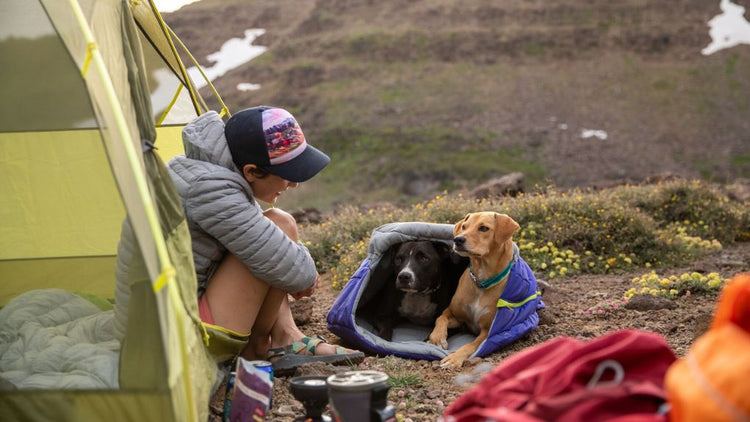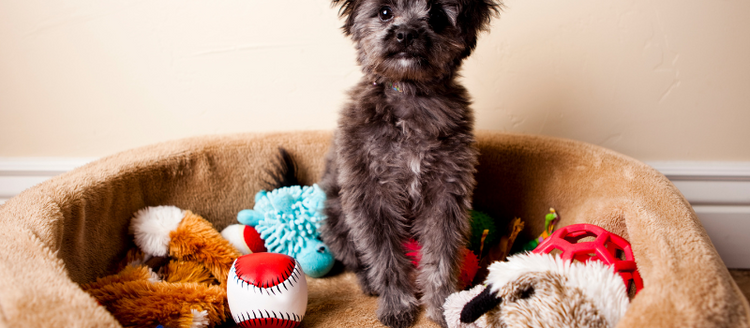
Summertime is just around the corner, and what better way to celebrate the warm weather than taking a camping trip with your dog.
Being properly prepared is key to making any camping trip with your dog a successful adventure, so here are our 5 top tips if you’re taking your dog camping for the first time.
1. Create a camping checklist for your dog
You’re going to need a few essential items with you for camping with your dog. Create a checklist so you don’t forget anything important when you’re packing.
Here are some items to consider packing for your dog on your camping trip:
- Freeze dried food
- Collapsible bowl for food
- 1 - 2 litre water bottle for your dog
- Toys for hanging around
- An alternative toy for chewing or edible chew toys such as Kangaroo tail
- Sealable containers for food (these can be any good containers from home)
- Treats and a treat bag
- A water resistant waste bag
- 30foot long line or a campsite tether system for dogs who like to explore
- A small light that can attach to your dogs collar
- A puppy first aid kit (and one for yourself too!)
- A muzzle for emergencies
- A cooling banana so your dog doesn’t overheat
- A lifejacket incase you take your dog out in deep waters
- A cooling mat or a regular mat to lay on around the campsite with extra blankets
- A baseline fleece and other essentials for warmth
- A recent photo of your dog
Here is an official printable checklist for all your camping needs!
2. Find a dog-friendly campsite
There are two important questions to answer when planning your camping trip:
- Does the campground allow dogs/what restrictions exist for dogs camping?
Many campsites have different policies when it comes to dogs, so make sure to call the campsite or check their website and read all of the requirements and rules before booking your trip. This ensures that you are bringing your dog to an accessible campsite that meets your dog's needs.
- Is the area safe for dogs?
It’s important to consider the terrain and amenities at the campground. Will your dog have a comfortable place to run and play? Where is the closest area for your dog to go to the bathroom? What’s the actual ground like at the campsite, and will it be comfortable for your dog for your stay?
Your campsites web page is a great source of information to help determine if a particular campsite is suitable for your dog. Be sure to check before you book!
3. Practice good campsite etiquette
It is always a great idea to be aware of neighbours and fellow dog parents. Keep your dog near you at all times and use your long line to ensure your dog doesn’t wander into other campsites.
It’s also important to instill good recall abilities in your dog, just in case they get off their lead. Practice recall training with your dog before leaving on your camping adventure.
Always pick up your dog’s waste and properly dispose of it.
Keep an eye out for wild animals that may wander into your campsite.
4. Know the signs of heatstroke
Heatstroke is far too common in dogs in the summertime, so it’s very important to know the signs and what to do if you suspect your dog may be overheating.
Signs of heatstroke in dogs may include:
- Heavy panting
- Rapid and/or difficulty breathing
- Increased heart rate with a bounding pulse
- Lethargy
- Lack of coordination
- Vomiting and diarrhea
- A deep red or purple coloured tongue
- Seizure
- Unconsciousness
- Excessive drooling/salivation
The reason for salivation during heat stroke is because your dog's body is working harder to get rid of the built up heat in the body. As the heatstroke worsens, you will notice your dog is having a harder time breathing. If this occurs, Flip the gums and tongue and look for bright red gums and bruises on the gums or skin.
If your dog has signs of heatstroke, the best thing to do is get your dog to a vet as soon as possible. If you happen to be far from a vet, do these things to help your dog in the meantime:
- Get your dog into the shade or a cool area
- Provide a cool surface for your dog to lay on ie: a cooling mat, a cool towel
- Use a fan or manually fan your dog
- Place a cool (but not ice cold) towel on the back of the neck, armpits and groin area
- Wet paws and ear flaps with cool water
- Use a rectal thermometer to keep track of the body temperature every couple of minutes
Make sure to not use super cold or frozen water as it can cause the blood vessels to constrict, keeping the heat in the body. Don’t force your dog to drink water and take them to a veterinary hospital as soon as you have access to one.
5. Know your dog's campsite personality
You know your dog the best, so consider their personality and typical behaviours when thinking about where you’ll be camping with your dog. Does your dog have a loud bark? Does your dog like to run off and explore? Is your dog friendly with other humans and pets? These are all great questions to ask yourself before taking your dog camping, so you can better prepare for a smooth trip in nature.
Another great thing to keep in mind is thinking about how adventurous your dog is. If your dog likes long hikes, trails, waterfalls or even new surroundings, maybe pick a campsite and area with lots of adventures. If your dog is timid, anxious or is known to be stressed in particular surroundings, find a campsite and place that is more quiet and comfortable. Plan accordingly and around your dog’s needs so you both can have a fun camping experience!
A bonus tip: Have fun and enjoy your very first camping trip with your dog!
Now that you are ready to prepare for your camping trip, you can follow along as we show you what essentials to bring for your camping trip in this video!

